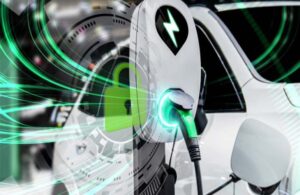 Sustainability and carbon neutrality have become the new anthem of this century.
Sustainability and carbon neutrality have become the new anthem of this century.
As more businesses are coming forward with the announcement of their commitment to achieving carbon neutrality in the next ten to twenty years, the automotive industry is witnessing one of its biggest overhauls of the century with the introduction and mass adoption of green mobility like renewably powered vehicles as well as electric vehicles.
On the other hand, as society transitions towards network connectivity, the emergence of cases of cyber-related crimes is trending at a high rate.
In a recent analysis of a credible report, around 100+ publicly reported automotive cyber-related incidents of 2022 were centered toward EV charging space.
Several types of cyber threats can potentially affect the EV charging process.
Common EV Charging Cybersecurity Threats
 Here are some common examples of EV Charging Cybersecurity Threats that include,
Here are some common examples of EV Charging Cybersecurity Threats that include,
-
Unauthorized Access
In most cases, hackers may attempt to gain unauthorized access to the charging station’s control systems or the backend infrastructure. Once inside, they could manipulate charging sessions, disrupt operations, or steal sensitive data. Hence, jeopardizing the process of EV Charging Cybersecurity.
-
Malware and Ransomware Attacks
Malicious software can be injected into charging station systems or EVs, allowing hackers to gain control or encrypt critical files, demanding a ransom for their release. This can disrupt charging operations or compromise the security of the EV’s systems.
-
Denial of Service (DoS) Attacks
Attackers may overload the charging infrastructure with excessive requests, rendering it unavailable to legitimate users. DoS attacks can disrupt charging services, causing inconvenience to EV owners and potentially impacting the charging station’s functionality. Therefore, counted as another EV Charging Cybersecurity Threats.
-
Man-in-the-Middle Attacks
In a man-in-the-middle attack, hackers intercept communication between the EV, charging station, and backend systems. This enables them to eavesdrop, modify data, or inject malicious commands, potentially compromising the integrity and security of the charging process.
-
Physical Attacks
Physical tampering with charging stations can also be counted as a cyber threat. Attackers may attempt to access charging station hardware, manipulate components, or install malicious devices that compromise the security and functionality of the infrastructure.
-
Social Engineering
Attackers may use social engineering techniques to deceive EV owners or charging station operators into revealing sensitive information, like login credentials or access codes. This information can then be exploited to gain unauthorized access to the charging infrastructure.
While EVs offer various benefits, their increasing connectivity to networks and the internet introduces security vulnerabilities.
To get more information on cyberthreats of EV Charging space, you can check out my previous article,” Cyber Threats on Electric Vehicles“.
Ways to Tackle EV Charging Cybersecurity Threats
 Here are some ways to tackle EV Charging Cybersecurity threats in the EV charging process:
Here are some ways to tackle EV Charging Cybersecurity threats in the EV charging process:
- Secure Communication: By implementing secure communication protocols between the charging station, EV, and backend systems, EV Charging Cybersecurity process can be safeguarded. Encryption and authentication mechanisms can help protect against eavesdropping and unauthorized access.
- Network Segmentation: Segregate the charging infrastructure from other critical systems to limit the potential attack surface. Employ firewalls and access controls to restrict unauthorized network access.
- Regular Software Updates: Keep charging station software and EV firmware up to date with the latest security patches. Regular updates of the network can also address known vulnerabilities and improve overall system security.
- Intrusion Detection Systems (IDS): Deploy IDS to monitor network traffic and detect any suspicious activities or anomalies. IDS can help identify potential cyber threats and enable prompt responses.
- User Authentication and Authorization: Implementing strong authentication mechanisms for EV owners and operators to access the charging infrastructure. Multi-factor authentication and secure access controls can mitigate unauthorized usage.
- Penetration Testing: Conduct regular penetration tests to identify vulnerabilities in the charging infrastructure. Since ethical hackers can simulate real-world attacks to uncover weaknesses, hence ensuring EV Charging Cybersecurity that need to be addressed.
- Security Audits: Perform security audits and risk assessments to evaluate the overall security posture of the charging infrastructure. Identify potential vulnerabilities and develop mitigation strategies.
- Data Protection: Ensure that sensitive user and vehicle data are protected. Implement data encryption, secure storage practices, and strict access controls to prevent unauthorized data breaches, thereby safeguarding EV Charging Cybersecurity.
- Collaborative Efforts: Promoting collaboration among industry stakeholders, including automakers, charging infrastructure providers, and cybersecurity experts. Sharing knowledge and best practices can help address emerging threats effectively.
- Regulatory Standards: Advocating for the development and implementation of cybersecurity standards specific to EV charging infrastructure. These standards can set minimum security requirements and foster a more secure ecosystem for EV Charging Cybersecurity.
 It’s important to note that cybersecurity is an ongoing process, and it requires continuous monitoring, evaluation, and improvement.
It’s important to note that cybersecurity is an ongoing process, and it requires continuous monitoring, evaluation, and improvement.
As technology evolves, new threats may emerge, so staying proactive and vigilant is crucial for EV Charging Cybersecurity to safeguard the process from cyber threats.
Constant monitoring, threat intelligence, and robust security measures are necessary to address these challenges and protect the integrity, privacy, and reliability of EV Charging systems.
